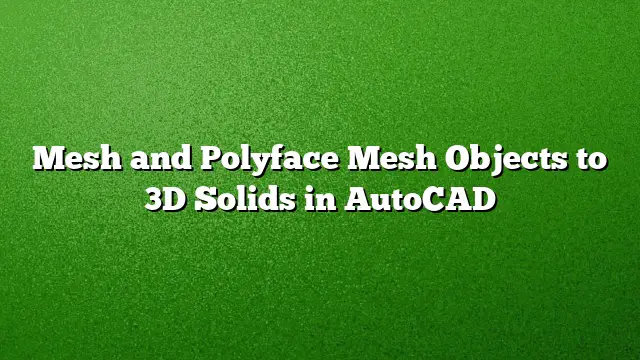Understanding Mesh and Polyface Mesh Objects
Defining Mesh and Polyface Mesh in AutoCAD
Mesh objects in AutoCAD are designed for representing complex surfaces, serving well in visualizing geometric shapes. A polyface mesh, on the other hand, is a specific type of mesh that allows for a more detailed representation by using a series of triangular or quadrilateral faces. These features enable users to create intricate designs that would be difficult to achieve with standard shapes.
Converting Mesh and Polyface Mesh to 3D Solids
Transforming mesh objects into 3D solids in AutoCAD 2025 is a straightforward process. It’s essential to understand this technique as it provides greater functionality for modeling and rendering.
-
Select the Mesh Object: Open your AutoCAD workspace where your mesh or polyface mesh object resides. Click on the object to highlight it.
-
Use the ‘Convert’ Command: Type
CONVERTin the command line and press Enter. This command is pivotal in changing mesh objects into 3D solid models. -
Follow the Prompt: AutoCAD will prompt you to select the mesh objects you wish to convert. Ensure you click on the correct mesh and follow the command line instructions.
-
Choose Output Options: After selecting the meshes, AutoCAD will provide various options for conversion. Choose the option that best fits your design requirements (such as specifying solid characteristics).
- Review the Resulting Solid: Once the conversion is complete, inspect the newly created 3D solid model to ensure it meets your expectations. You can manipulate it further using standard solid editing tools.
Advantages of Converting to 3D Solids
-
Enhanced Editing Capabilities: 3D solids offer more robust editing tools compared to mesh and polyface mesh objects, allowing for better manipulation of geometries.
-
Improved Rendering Performance: Rendering solids usually results in better performance and visual quality, making them more suitable for presentation and execution.
- Compatibility with Other Features: Solid models are more compatible with other AutoCAD features and utilities, such as 3D printing, simulations, and advanced architectural visualizations.
Troubleshooting Common Issues
While converting mesh to 3D solid, users may encounter challenges:
-
Deformed Solid: If the solid appears distorted, it may be necessary to review the original mesh structure. Check the mesh for irregularities before conversion.
-
Failed Conversion: Occasionally, AutoCAD might not complete the conversion due to mesh complexity. Simplifying the mesh may help.
- Performance Lag: Larger meshes can slow down processing. If performance issues arise, consider reducing mesh detail or using layers to manage visibility.
Frequently Asked Questions (FAQs)
1. Can I convert multiple mesh objects at once?
Yes, AutoCAD allows you to select multiple mesh objects during the conversion process. Simply highlight all the desired meshes before executing the convert command.
2. Is it necessary to clean up the mesh before conversion?
While not mandatory, it’s advisable to clean up any overlapping or unnecessary vertices and edges to ensure the conversion process goes smoothly.
3. Are there alternative methods for creating complex geometries?
Besides converting mesh objects, you could use native AutoCAD solid modeling commands to create complex shapes directly, such as EXTRUDE, REVOLVE, and SWEEP.

